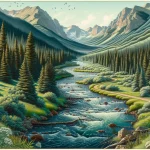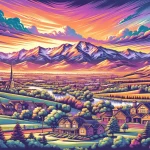Discover the awe-inspiring landscapes and captivating history of the Grand Mesa Scenic and Historic Byway, a 63-mile route that showcases Colorado’s natural beauty and cultural heritage. This scenic drive offers breathtaking views of the world’s largest flat-top mountain, boasting over 300 pristine lakes and diverse ecosystems.
In This Article
TL;DR
- The Grand Mesa Scenic and Historic Byway spans a significant elevation, offering diverse climates and ecosystems.
- Key attractions include historical sites, natural landmarks, and recreational opportunities.
- The byway plays a crucial role in boosting local tourism and economy.
Historical Significance of the Byway
The Grand Mesa Scenic and Historic Byway has a rich history dating back to the late 1800s. The Utes called the Grand Mesa “Thunder Mountain” due to its impressive stature. In 1776, the Dominguez-Escalante expedition traversed the mesa with the help of Ute guides. As settlers moved to Colorado, the U.S. government made treaties with the Utes, eventually relocating them to reservations in Utah and southwestern Colorado.
The byway itself was established in 1996 when the Grand Mesa Scenic Byway and Land’s End Road were designated as the Grand Mesa National Scenic Byway. This designation recognizes the historical importance and cultural impact of the route on local communities.
Natural Wonders Along the Byway
The Grand Mesa Scenic and Historic Byway showcases a diverse array of geological formations and natural landscapes. The mesa rises to an average elevation of 10,000 feet, with Crater Peak reaching 11,333 feet. Despite being surrounded by arid valleys, the mesa is covered in dense vegetation and hundreds of lakes.
The unique geography of the Grand Mesa is attributed to natural forces rather than glaciation. Groundwater has filled compressions formed by the mesa’s shifting volcanic rock, creating over 300 lakes. These lakes support a thriving ecosystem and provide habitats for various flora and fauna.
Recreational Opportunities
The Grand Mesa Scenic and Historic Byway offers a wide range of recreational activities for visitors to enjoy. During the summer, popular activities include:
- Hiking and biking on numerous trails, such as the Crag Crest Trail and Mesa Top Trail
- Fishing in the mesa's abundant lakes, including Island Lake and Mesa Lake
- Wildlife viewing opportunities, with the chance to spot moose and other animals
In the winter, the Grand Mesa transforms into a snowy wonderland, offering:
- Cross-country skiing on groomed trails maintained by the Grand Mesa Nordic Council
- Snowmobiling on the mesa's wide-open terrain and forest service roads
- Downhill skiing at Powderhorn Mountain Resort
Visitor Amenities and Facilities
To enhance the visitor experience, the Grand Mesa Scenic and Historic Byway provides various amenities and facilities. Visitors can find lodging options, including the Grand Mesa Lodge situated by Island Lake. Local restaurants offer a taste of the region’s cuisine.
Informational signage and visitor centers along the route provide valuable insights into the area’s history, geology, and ecology. The Grand Mesa Visitor Center offers easy access to restrooms and an accessible boat ramp.
Economic Impact and Community Benefits
The Grand Mesa Scenic and Historic Byway significantly contributes to the local economy by attracting tourists and supporting local businesses. The influx of visitors creates job opportunities in the tourism and hospitality sectors.
The byway designation has also led to improvements in transportation infrastructure and facilities, benefiting both tourists and local communities. Future development plans and community projects aim to enhance the visitor experience while preserving the natural and historical integrity of the area.
FAQ
What is the length of the Grand Mesa Scenic and Historic Byway?
The Grand Mesa Scenic and Historic Byway spans 63 miles, connecting the town of Cedaredge with Interstate 70 near Mesa.
How can visitors best prepare for the changing elevations along the byway?
Visitors should be prepared for varying weather conditions and pack appropriate clothing layers due to the significant elevation changes along the byway.
What are some must-see attractions along the Grand Mesa Scenic Byway?
Must-see attractions include the Land’s End Observatory, Crag Crest Trail, Island Lake, Rocky Mountain National Park, and the numerous scenic overlooks offering panoramic views of the surrounding landscapes, the Colorado National Monument, and the Grand Mesa National Forest.
Are there any special permits required for recreational activities along this Colorado scenic byway?
Some recreational activities, such as fishing, may require permits. Visitors should check with local authorities or visitor centers for information on necessary permits and regulations.
What are the best times of year to visit the Grand Mesa Scenic and Historic Byway?
The Grand Mesa Scenic and Historic Byway offers unique experiences throughout the year. Summer is ideal for hiking, fishing, and sightseeing, while winter provides opportunities for snow-based activities like cross-country skiing and snowmobiling.







